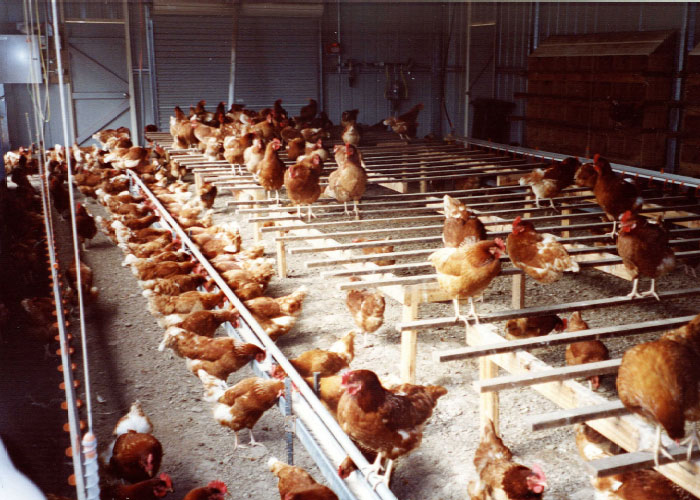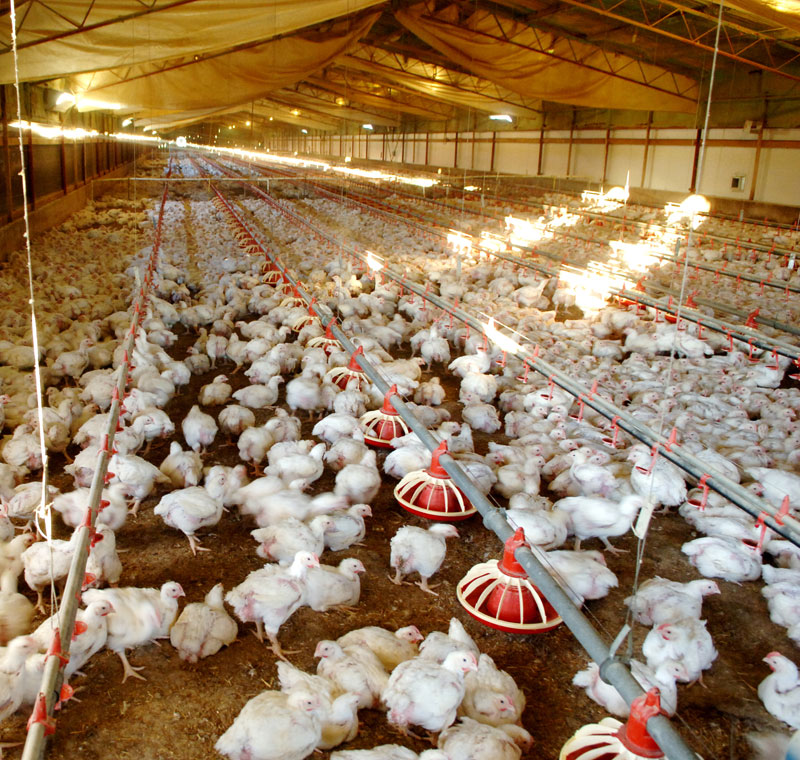Nutrition
Poultry Nutrient Requirements
Poultry diets must be formulated to provide all of the bird’s nutrient requirements if optimum growth and production is to be achieved. There are six classes of nutrients:
- Carbohydrates – the major source of energy for poultry. Most of the carbohydrate in poultry diets is provided by cereal grains.
- Fats – provide energy and essential fatty acids that are required for some bodily processes.
- Proteins – required for the synthesis of body tissue (particularly muscle), physiological molecules (such as enzymes and hormones), feathers and for egg production. Proteins also provide a small amount of energy.
- Vitamins – organic chemicals (chemicals containing carbon) which help control body processes and are required in small amounts for normal health and growth.
- Minerals – inorganic chemicals (chemicals not containing carbon) which help control body processes and are required for normal health and growth.
- Water.
Factors affecting the nutrient requirements of poultry
The nutrient requirements of poultry are affected by a large number of factors, including:
- Genetics (the species, breed or strain of bird) – Different species, breeds or strains of birds have different average body sizes, growth rates and production levels and will absorb and utilise nutrients from feed with different levels of efficiency. Therefore, they will require feed with different nutrient compositions. The genetics of commercial poultry is constantly changing, and as a result, so are their nutrient requirements. Consequently, breeders of commercial poultry provide information on the specific nutrient requirements for the birds they sell.
- Age – nutrient requirements are related to both body weight and the stage of maturity in bird.
- Sex – prior to sexual maturity, the sexes have only small differences in their nutrient requirements and males and females can usually be fed the same compromise diet to achieve acceptable growth rates. Differences in nutrient requirements are larger following the onset of sexual maturity and significantly different diet formulations are then required for each sex.
- Reproductive state – the level of egg production in hens and sexual activity in males will affect nutrient requirements.
- Ambient temperature – poultry have increased energy requirements to maintain normal body temperature in cold ambient temperatures and the opposite in hot ambient temperatures. Food digestion processes produce body heat, the amount of which will vary according to the nutrient composition of the diet. This is called the heat increment of the diet. In cold temperatures it may be desirable to formulate a diet with a higher heat increment and the opposite in hot temperatures.
- Housing system – the type of housing system will influence the level of activity of the birds and therefore their energy requirements.
- Health status – birds experiencing a disease challenge may benefit from an increase in the intake of some nutrients, most commonly vitamins.
- Production aims – the optimal nutrient composition of the diet will vary according to production aims, such as optimising weight gain or carcass composition, egg numbers or egg size. Poultry that are raised for breeding purposes may need to have their energy intake restricted to ensure that they do not become obese.
Feed intake

Barn layer system
The nutrient intake of poultry is affected by both the nutrient composition of the diet and the amount of feed eaten or feed intake. The optimum nutrient intake for poultry raised commercially will depend on the commercial goals of the poultry enterprise.
The goals in feeding poultry differ between different classes of poultry. In general, for poultry raised to provide meat, such as broilers, the aim is to produce the maximum body weight gain for the minimum cost of feed while controlling the amount of fat on the carcass. For egg laying birds, the aim is to maximise egg production for the minimum cost of feed while controlling the egg size and egg quality. For mature egg laying birds this generally entails maintaining a relatively stable body weight. These different goals, along with differences in digestion and absorption of nutrients, require different levels of nutrients to be provided to different classes of poultry.
The nutrient intake of poultry can be controlled by limiting the amount of feed available to be eaten, by adjusting the nutrient content of the diet to match voluntary feed intake or by manipulating the lighting program through increasing or decreasing the duration of darkness. Allowing poultry to eat as much as they want is called ad libitum feeding.
There are a range of factors that can affect the voluntary feed intake of poultry, these include:
- Breed or strain
- Age
- Nutrient balance of the diet
- Ambient temperature
- Health and welfare status of the birds
- Accessibility of the feed
- Flock density
In addition, certain feed ingredients, poor feed quality or feed contamination can have adverse effects on voluntary feed intake due to poor palatability or the presence of toxic factors.
Suppliers of commercial poultry provide information on the optimum nutrient and feed intakes for their birds throughout the production cycle. Feed intake and production performance of flocks should be monitored and adjustments made to the diet composition where required to keep performance on track. In particular, feed intake is readily affected by ambient temperature, with feed intake increasing at lower ambient temperatures and decreasing at higher ambient temperatures. In such cases, the diet may need to be reformulated to adjust nutrient intake to match changes in voluntary feed intake as a result of changes in ambient temperature. As an example, in high ambient temperatures, a more concentrated diet can compensate for the decreased nutrient intake occurring as a result of lower voluntary feed intake. Accessibility to feed is sometimes overlooked as a limiting factor and can be caused through inappropriate or poorly adjusted feeding equipment or inadequate feeding space due to overstocking of facilities. The height of the feeders should be adjusted according to the flock age to provide easy access to the feed for all the birds.
Water consumption rates for chickens
Water is an essential nutrient for life. Water consumption can be limited if the water is too hot or is contaminated with excess minerals. Water and food consumption rates are interdependent, so reduced water intake can also lead to reduced food intake. There are other factors that affect water intake, with temperature being the most obvious one. For example, chickens drink between 30-50% more water when the environmental temperature is above 32oC compared with when it is 21oC. Water intake is also affected by the type of drinkers used. The rule of thumb for water intake is that water intake is usually 1.5 to 2 times feed intake. Tables 1 and 2 provide data on typical water consumption levels for layers and broilers, respectively, at 21oC.

Table 1. Typical daily water consumption for layers
| Production Stage | Age/Rate of Production | Litres of water per 1000 birds at 21oC |
| Layer pullet | 4 weeks | 100 |
| 12 weeks | 160 | |
| 18 weeks | 200 | |
| Laying hens | 50% production | 220 |
| 90% production | 270 |
Source: Poultry CRC
Table 2. Typical daily water consumption for broilers at 20oC (litres per 1000 mixed sex birds)
| Age (weeks) | ||||||||
| 1 | 2 | 3 | 4 | 5 | 6 | 7 | 8 | |
| Water Intake (litres) | 65 | 120 | 180 | 245 | 290 | 330 | 355 | 370 |

